Monthly Archives: May 2021
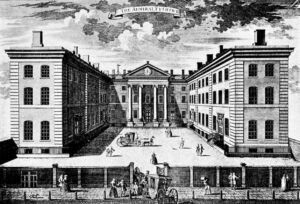 In a war, good intel is crucial. The opposing armies always use codes in messages so that their plans are not known. Breaking codes is not an easy task, nor is it a quick task. During World War I, the cryptanalysis section of the British Admiralty was called Room 40, also known as 40 O.B. (Old Building) (latterly NID25). The unit was formed in October 1914. It began when Rear-Admiral Henry Oliver, the Director of Naval Intelligence, gave intercepts from the German radio station at Nauen, near Berlin, to Director of Naval Education Alfred Ewing, who constructed ciphers as a hobby.
In a war, good intel is crucial. The opposing armies always use codes in messages so that their plans are not known. Breaking codes is not an easy task, nor is it a quick task. During World War I, the cryptanalysis section of the British Admiralty was called Room 40, also known as 40 O.B. (Old Building) (latterly NID25). The unit was formed in October 1914. It began when Rear-Admiral Henry Oliver, the Director of Naval Intelligence, gave intercepts from the German radio station at Nauen, near Berlin, to Director of Naval Education Alfred Ewing, who constructed ciphers as a hobby.
Ewing began recruiting civilians such as William Montgomery, who was a translator of theological works from German, and Nigel de Grey, who was a publisher. During the war, the war Room 40 decrypted around 15,000 intercepted German communications from wireless and telegraph traffic. The section’s most notable work was when they intercepted and decoded the Zimmermann Telegram, a secret diplomatic communication issued from the German Foreign Office in January 1917 that proposed a military alliance between Germany and Mexico. This was the most significant intelligence triumph for Britain during World War I, because it played a significant role in drawing the then-neutral United States into the conflict.
Room 40 operations began simply with the acquisition of a captured German naval codebook, the Signalbuch der Kaiserlichen Marine (SKM), and maps (containing coded squares) that Britain’s Russian allies had passed on to the Admiralty. Before long it was playing a vital part in the intelligence industry. It all started when the Russians seized this material from the German cruiser SMS Magdeburg after it ran aground off the Estonian coast on August 26, 1914. The Russians recovered three of the four copies that the warship had carried. They retained two and passed the other to the British. In October 1914 the British also obtained the Imperial German Navy’s Handelsschiffsverkehrsbuch (HVB), a codebook used by German naval warships, merchantmen, naval zeppelins and U-Boats. The Royal Australian Navy seized a copy from the Australian-German steamer Hobart on October 11th. Then, on November 30th, a British trawler recovered a safe from the sunken German destroyer S-119, in which was found the Verkehrsbuch (VB), the code used by the Germans to communicate with naval attachés, embassies and warships overseas. It was an amazing find. In March 1915 a British 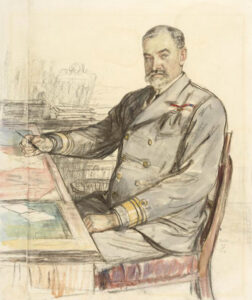 detachment impounded the luggage of Wilhelm Wassmuss, a German agent in Persia and shipped it, unopened, to London, where the Director of Naval Intelligence, Admiral Sir William Reginald Hall discovered that it contained the German Diplomatic Code Book, Code No. 13040.
detachment impounded the luggage of Wilhelm Wassmuss, a German agent in Persia and shipped it, unopened, to London, where the Director of Naval Intelligence, Admiral Sir William Reginald Hall discovered that it contained the German Diplomatic Code Book, Code No. 13040.
The section retained “Room 40” as its informal name even though it expanded during the war and moved into other offices. Alfred Ewing directed Room 40 until May 1917, when direct control passed to Captain (later Admiral) Reginald ‘Blinker’ Hall, assisted by William Milbourne James. Although Room 40 successfully decrypted Imperial German communications throughout World War I, its function was compromised by the Admiralty’s insistence that all decoded information would only be analyzed by Naval specialists. This meant while Room 40 operators could decrypt the encoded messages they were not permitted to understand or interpret the information themselves. Whatever they couldn’t do, they accomplished a very great deal.
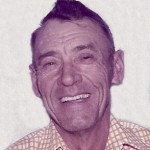
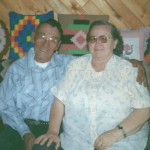 I can’t believe that it has been eight long years since my father-in-law, Walt Schulenberg passed away. He was such a big part of my life, and the lives of his whole family. His sense of humor and wit brightened our days, and made us laugh. He loved hearing the laughter of his family. It just seems impossible that he has been gone for eight years already. I really miss him very much.
I can’t believe that it has been eight long years since my father-in-law, Walt Schulenberg passed away. He was such a big part of my life, and the lives of his whole family. His sense of humor and wit brightened our days, and made us laugh. He loved hearing the laughter of his family. It just seems impossible that he has been gone for eight years already. I really miss him very much.
Dad was a very talented man. He really got into the craft things later in his life. He did some large craft things like remaking lawn chairs, and his whirlygigs, but he made some small things too, like a puzzle made out of nuts and bolts, that you had to untangle, or the little novelty items made out of beans and coal. I don’t recall what those were exactly, but they usually had some funny little saying on them and a joke about the items glued on the card it was all put together on. In reality, they were little nothings, but they were funny, and the people at the craft fairs bought that stuff. I never could figure out how that stuff sold, but I suppose that it wasn’t the item itself, but rather the comedian selling the stuff that made it sell.
Dad was creative in so many other ways though, that were not funny…they were beautiful. He made steps for friends in Arizona when they used to spend the Winter in Yuma. He couldn’t stand to just sit still. He had to stay busy, and that was a great thing for the people he made things for. He would also go out into the desert to find things he could use for his crafts. I was always a little nervous about him wandering around in the desert, but he knew his way around, and his adventures were always fruitful. He found great stuff, and his artistic side turned the stuff into something that some one would like.
The people who knew him lost a great man eight years ago, and that is something that has left a hole in our 
 lives. I miss his smile, and his welcoming ways. I feel very fortunate to have been able to call him my father-in-law, and my second dad. I know that many people don’t like their in-laws, and I find that very sad, because most in-laws have so much to offer to the people their children have married. I suppose you have to be willing to look at the gift you have been given, and be thankful for it, and I am so thankful for the gift of my father-in-law (and my mother-in-law), because they were awesome. I wish they were still here with us, because I miss them both very much.
lives. I miss his smile, and his welcoming ways. I feel very fortunate to have been able to call him my father-in-law, and my second dad. I know that many people don’t like their in-laws, and I find that very sad, because most in-laws have so much to offer to the people their children have married. I suppose you have to be willing to look at the gift you have been given, and be thankful for it, and I am so thankful for the gift of my father-in-law (and my mother-in-law), because they were awesome. I wish they were still here with us, because I miss them both very much.

 There are places in this world that have hidden places in them that might just surprise most people. At one time, these hidden places might have had a useful purpose, but later their usefulness was gone, and they were either closed up or removed altogether. The Brooklyn Bridge in New York City is one of those places. You can’t really remove a hidden place in a bridge, but you can close the hidden places up if they are no longer needed.
There are places in this world that have hidden places in them that might just surprise most people. At one time, these hidden places might have had a useful purpose, but later their usefulness was gone, and they were either closed up or removed altogether. The Brooklyn Bridge in New York City is one of those places. You can’t really remove a hidden place in a bridge, but you can close the hidden places up if they are no longer needed.
When the Brooklyn Bridge was built, portions of surrounding neighborhoods in Manhattan and Brooklyn had to be demolished in order to build the bridge’s two anchorage sections, which attach the bridge to land. This affected several local merchants more so than others, and because of that impact, the situation had to be addressed. To compensate local merchants and offset some of the bridge’s $15 million budget, wine cellars and other vaulted spaces were incorporated into the bridge’s design. The storage space that had once belonged to the merchants, had to be replaced with useable space, so several wine merchants and other alcohol sellers began renting the spaces in 1883, when the bridge was completed, and except for the Prohibition years, the cellars remained in operation until World War II.
The wine cellars were filled with wine before the Brooklyn Bridge was even operational. The cellars were the idea of bridge engineer John Roebling, and they were completed by his son Washington Roebling after John died. They were created as a solution to an alcohol problem, designed with the hoped that building the cellars would keep the wine dark, cool and secure. The cellars were huge. They are connected by a series of twisting tunnels named after French roads.
Prohibition brought a new era for the cellars. They were turned into newspaper storage areas. When Prohibition 
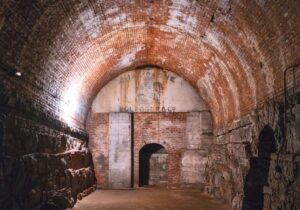 ended, they briefly reopened to the public, but World War II led the city of New York to take over permanent management of the cellars and close them to visitors. Since then, almost no one has seen them. The cellars remain empty and forgotten by the thousands of pedestrians and motorists who cross the Brooklyn Bridge every day. They are used for storage, and an occasional homeless person who finds their way inside.
ended, they briefly reopened to the public, but World War II led the city of New York to take over permanent management of the cellars and close them to visitors. Since then, almost no one has seen them. The cellars remain empty and forgotten by the thousands of pedestrians and motorists who cross the Brooklyn Bridge every day. They are used for storage, and an occasional homeless person who finds their way inside.
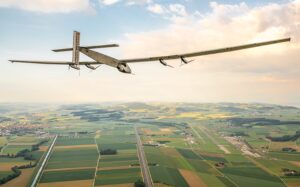 We are all used to alternative forms of energy these days. From electric cars to solar heating to wind energy, things have changed some. One thing I had never heard of before, however, is a solar-powered airplane. Of course, the plane was built to promote green energy, and I don’t personally think that green energy is a totally feasible option…sorry if anyone disagrees. Nevertheless, someone came up with the idea of using solar energy for an airplane. I have to admit that the idea of a plane operating totally on solar energy is something that would make me a little apprehensive, nevertheless, one was developed. And it was successful too. A solar-powered airplane completing the 10th leg of it’s journey by landing in Arizona after a 16-hour flight from California in 2015. Now, admittedly, a normal plane could have made the trip in a couple of hours, so in that way, it was rather anticlimactic.
We are all used to alternative forms of energy these days. From electric cars to solar heating to wind energy, things have changed some. One thing I had never heard of before, however, is a solar-powered airplane. Of course, the plane was built to promote green energy, and I don’t personally think that green energy is a totally feasible option…sorry if anyone disagrees. Nevertheless, someone came up with the idea of using solar energy for an airplane. I have to admit that the idea of a plane operating totally on solar energy is something that would make me a little apprehensive, nevertheless, one was developed. And it was successful too. A solar-powered airplane completing the 10th leg of it’s journey by landing in Arizona after a 16-hour flight from California in 2015. Now, admittedly, a normal plane could have made the trip in a couple of hours, so in that way, it was rather anticlimactic.
The plane was the brain-child of Bertrand Piccard, who dreamed of an airplane of perpetual endurance…able to fly day and night without fuel. With the construction of this plane, that dream had been realized, and with the flight of co-founder Andre Borschberg’s flight, history had been made. Still, who has 16 hours to make that flight, when you can drive it in 12 hours. The spindly, single-seat experimental aircraft, dubbed Solar Impulse 2, arrived in Phoenix shortly before 9pm, following a flight from San Francisco that took it over the Mojave  Desert. The solar plane’s pilots were required to take up meditation and hypnosis in training, so they could stay alert for long periods.
Desert. The solar plane’s pilots were required to take up meditation and hypnosis in training, so they could stay alert for long periods.
The plane’s capacity was one…just the pilot in the tiny cockpit. Andre Borschberg, who alternated with fellow pilot Bertrand Piccard at the controls for each segment of what they hope will be the first round-the-world solar-powered flight. “I made it to Phoenix, what an amazing flight over the Mojave desert,” Borschberg said in a Twitter post. Borschberg was the pilot for the Japan-to-Hawaii trip over the Pacific last July, staying airborne for nearly 118 hours…shattering the prior record of 76 hours for a non-stop, solo flight set back in 2006 by the late Steven Fossett in his Virgin Atlantic Global Flyer. Solar Impulse 2 set new duration and distance records for solar-powered flight too.
Not all was picture-perfect with the venture, however. The project was dealt a setback when the Solar Impulse suffered severe battery damage, requiring repairs and testing that grounded it in Hawaii for nine months. After repairs were made, Piccard completed the trans-Pacific crossing, reaching San Francisco after a flight of nearly three days, more than three times the 18 hours Amelia Earhart took to fly solo from Hawaii to California in the 1930s. In many ways, the project would seem to be a failure, but the one real success it had was that the  flights were made without fuel. Its four engines were powered solely by energy collected from more than 17,000 solar cells built into its wings. Surplus power is stored in four batteries during the day, to keep the plane aloft on extreme long-distance flights. The carbon-fiber plane, with a wingspan exceeding that of a Boeing 747 and the weight of a family car, is unlikely to set speed or altitude records. It can climb to 28,000 feet, and cruise at 34 to 62 miles per hour. It’s not something I think I would choose to fly in, but then it’s possible that down the road, when it isn’t an experimental plane, and it can carry more people, I might find myself traveling in just such a plane.
flights were made without fuel. Its four engines were powered solely by energy collected from more than 17,000 solar cells built into its wings. Surplus power is stored in four batteries during the day, to keep the plane aloft on extreme long-distance flights. The carbon-fiber plane, with a wingspan exceeding that of a Boeing 747 and the weight of a family car, is unlikely to set speed or altitude records. It can climb to 28,000 feet, and cruise at 34 to 62 miles per hour. It’s not something I think I would choose to fly in, but then it’s possible that down the road, when it isn’t an experimental plane, and it can carry more people, I might find myself traveling in just such a plane.
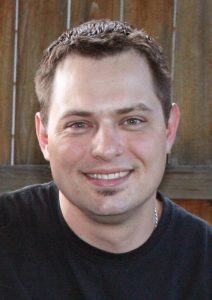
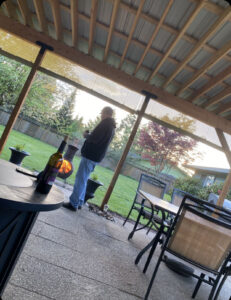 My son-in-law, Travis Royce is rather a fanatic when it comes to his yard. He really always has been. When you think about it, that works out very well for my daughter, Amy…his wife. It’s not that Travis does all the work, but that he is happy to help with the projects that make their back yard a sanctuary where they love to spend time. This year, they have been working on their covered patio are. Travis built that a while back, and now they are adding to the ambiance with lighting, flower gardens, and games, like the latest addition to the back yard…darts. They got the dart board up, and I mentioned to Amy that now she could beat him at darts indoors and outdoors. Well, she informed me that he won the first game played out on the patio. They are both good dart
My son-in-law, Travis Royce is rather a fanatic when it comes to his yard. He really always has been. When you think about it, that works out very well for my daughter, Amy…his wife. It’s not that Travis does all the work, but that he is happy to help with the projects that make their back yard a sanctuary where they love to spend time. This year, they have been working on their covered patio are. Travis built that a while back, and now they are adding to the ambiance with lighting, flower gardens, and games, like the latest addition to the back yard…darts. They got the dart board up, and I mentioned to Amy that now she could beat him at darts indoors and outdoors. Well, she informed me that he won the first game played out on the patio. They are both good dart 
 players, so my comment was really a joke, but Travis proved that he has a good handle on the game. They have several back yard games that they like to play, but they also like to just sit and relax…enjoying the quiet nights.
players, so my comment was really a joke, but Travis proved that he has a good handle on the game. They have several back yard games that they like to play, but they also like to just sit and relax…enjoying the quiet nights.
Travis is a homebody in many ways, something I would never have expected when he and Amy first started dating, about 27 years ago, but time changes us all. Those party/bar scenes get old after a while, and it too loud anyway, so most people would rather have friends over and enjoy a little bit more quiet party atmosphere. Nevertheless, Amy and Travis do like to go to the casinos in their area, and they tend to do pretty well there. Still, they aren’t about throwing their money away, they just play for fun periodically. When we go to visit, we enjoy that too, and 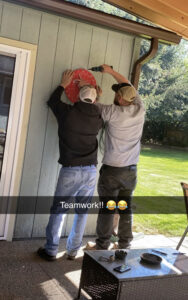
 sometimes we do pretty well. Maybe it’s all about having them there with us, I don’t know. Sometimes, I think we should give them our money to play while we stand and watch.
sometimes we do pretty well. Maybe it’s all about having them there with us, I don’t know. Sometimes, I think we should give them our money to play while we stand and watch.
Travis is an excellent “griller,” as anyone who has had his food can attest. If the cooking is being done indoors, Amy is the cook, but if it’s being done outdoors, it’s all Travis. He prides himself in grilling great steaks and seafood too. His friends consider themselves lucky to have been invited for the barbecue. Amy and Travis are very social people, and entertaining is something they both enjoy, so those summer barbecues are always fun times for them and for everyone who is privileged to attend. Today is Travis’ birthday. Happy birthday Travis!! Have a great day!! We love you!!
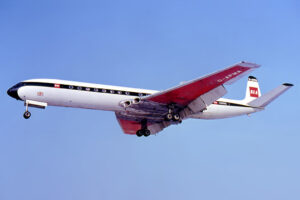 As planes became more and more common, it became evident that at some point, they were going to be used commercially. Still, I can’t imagine being on that first commercial flight. I doubt if it comes as a surprised that the first commercial flight in history occurred in the United States. What is surprising is that the flight took place on January 1, 1914, three years before the United States entered World War I. Planes weren’t commonly used forms of transportation in any arena, so a commercial flight is almost beyond imagination. Following that first flight, the Vickers Viscount emerged in 1948, as the first commercial airliner to use turboprop power. That plane was equipped with four Rolls-Royce Dart turboprop engines, the British aircraft had a pressurized cabin and was capable of carrying 40 to 65 passengers.
As planes became more and more common, it became evident that at some point, they were going to be used commercially. Still, I can’t imagine being on that first commercial flight. I doubt if it comes as a surprised that the first commercial flight in history occurred in the United States. What is surprising is that the flight took place on January 1, 1914, three years before the United States entered World War I. Planes weren’t commonly used forms of transportation in any arena, so a commercial flight is almost beyond imagination. Following that first flight, the Vickers Viscount emerged in 1948, as the first commercial airliner to use turboprop power. That plane was equipped with four Rolls-Royce Dart turboprop engines, the British aircraft had a pressurized cabin and was capable of carrying 40 to 65 passengers.
While I would have expected the world’s first commercial jet airliner to follow suit and come from the United States, it did not. The de Havilland DH.106 Comet, the world’s first commercial jet airliner, was actually developed and manufactured by de Havilland at its Hatfield Aerodrome in Hertfordshire, United Kingdom. The Comet 1 prototype first flew in 1949. It featured an aerodynamically clean design with four de Havilland Ghost turbojet engines buried in the wing roots, a pressurized cabin, and large square windows. It’s relatively quiet, comfortable passenger cabin and innovative design, made the plane commercially promising at its debut on this 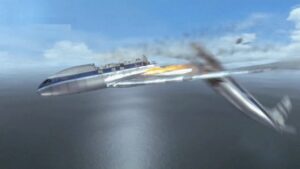 day, May 2, 1952. Unfortunately, within a year of entering service, the plane began to experience problems. Three Comets were lost within twelve months in highly publicized accidents, after suffering catastrophic in-flight break-ups. Two of the break-ups proved to be caused by structural failure resulting from metal fatigue in the airframe, a phenomenon not fully understood at the time. The third break-up was due to overstressing of the airframe during flight through severe weather. That flight might have had problems even if it had been a more advanced plane, because weather related crashes are still somewhat common today.
day, May 2, 1952. Unfortunately, within a year of entering service, the plane began to experience problems. Three Comets were lost within twelve months in highly publicized accidents, after suffering catastrophic in-flight break-ups. Two of the break-ups proved to be caused by structural failure resulting from metal fatigue in the airframe, a phenomenon not fully understood at the time. The third break-up was due to overstressing of the airframe during flight through severe weather. That flight might have had problems even if it had been a more advanced plane, because weather related crashes are still somewhat common today.
Due the the problems, the Comet was withdrawn from service and extensively tested. Design and construction flaws, including improper riveting and dangerous concentrations of stress around some of the square windows, were ultimately identified as the points of the fatigue. As a result, the Comet was extensively redesigned, with oval windows, structural reinforcements and other changes. Rival manufacturers meanwhile heeded the lessons learned from the Comet while developing their own aircraft. I guess there always has to be that one we learned from. Unfortunately, when people get scared about something, it is very hard to recover in the courts of public opinion.
 Sadly, sales of the Comet 1 never fully recovered after the crashes. The improved Comet 2 and the prototype Comet 3 culminated in the redesigned Comet 4 series which debuted in 1958 and did quite well, remaining in commercial service until 1981. Later, the Comet was adapted for military usage. It played a variety of military roles such as VIP, medical and passenger transport, as well as surveillance. In 1997, the last Comet 4 was used as a research platform, making its final flight later that year. The most extensive modification resulted in a specialized maritime patrol derivative, the Hawker Siddeley Nimrod, which remained in service with the Royal Air Force until 2011, over 60 years after the Comet’s first flight.
Sadly, sales of the Comet 1 never fully recovered after the crashes. The improved Comet 2 and the prototype Comet 3 culminated in the redesigned Comet 4 series which debuted in 1958 and did quite well, remaining in commercial service until 1981. Later, the Comet was adapted for military usage. It played a variety of military roles such as VIP, medical and passenger transport, as well as surveillance. In 1997, the last Comet 4 was used as a research platform, making its final flight later that year. The most extensive modification resulted in a specialized maritime patrol derivative, the Hawker Siddeley Nimrod, which remained in service with the Royal Air Force until 2011, over 60 years after the Comet’s first flight.
 Some holidays celebrate one thing and one thing only, but others, such as May Day, can have several meanings. When my sisters and I were children, May Day was a special day. Our mom, Collene Spencer would go to the story and buy candy. We made baskets out of construction paper and put candy in them. Then we would sneak around the neighborhood, hang the baskets on the front door of a neighbor and knock on the door. Then, we would run and hide. Sometimes they would catch us, and sometimes they would just yell out “thank you,” but they were always pleased that we though of them and did something nice for them.
Some holidays celebrate one thing and one thing only, but others, such as May Day, can have several meanings. When my sisters and I were children, May Day was a special day. Our mom, Collene Spencer would go to the story and buy candy. We made baskets out of construction paper and put candy in them. Then we would sneak around the neighborhood, hang the baskets on the front door of a neighbor and knock on the door. Then, we would run and hide. Sometimes they would catch us, and sometimes they would just yell out “thank you,” but they were always pleased that we though of them and did something nice for them.
Many people look at May Day as celebrating the beginning of the summer season, or at least the warmer part of Spring. It is a day when it seems like suddenly the flowers have all begun to bloom, the grass gets green, and the trees got their leaves. That is a great way to think about it, because for me Spring and Summer are the best times of the year. I love being able to get out and hike and just enjoy the warm weather. Some of the celebrations included a Maypole dance where ribbons were wrapped around a pole to create a work of art. The ribbons are multi-colored, so its like braiding them together. Its a great game for the kids…and a great welcome to Summer!!
In the United States, May first has another meaning…it is also Law Day. These days it is questionable as to how people  feel about that, but to me it is an important day. Our nation needs law and order, and I believe that most people would agree. Law Day is a day meant to reflect on the role of law in the foundation of the country and to recognize its importance for society. These days there are people who are against the police, except when they need one, and then suddenly the police are very important. I have and have had law enforcement officers in my family, and I can say that they are some of the most caring people I know. So to them I say Happy Law Day!! To everyone else, Happy May Day!!
feel about that, but to me it is an important day. Our nation needs law and order, and I believe that most people would agree. Law Day is a day meant to reflect on the role of law in the foundation of the country and to recognize its importance for society. These days there are people who are against the police, except when they need one, and then suddenly the police are very important. I have and have had law enforcement officers in my family, and I can say that they are some of the most caring people I know. So to them I say Happy Law Day!! To everyone else, Happy May Day!!

